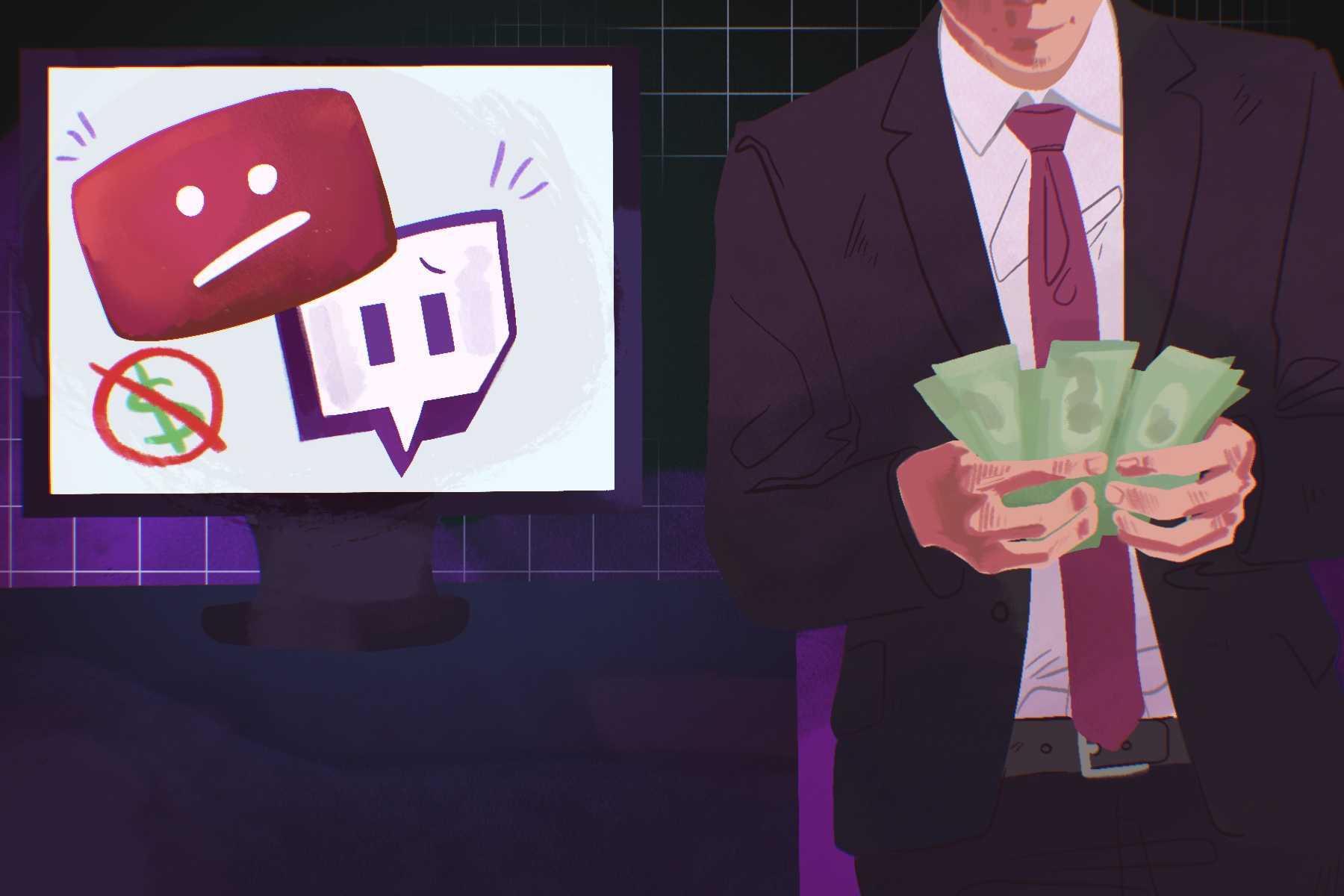Since their inception, online video-sharing and streaming platforms like YouTube and Twitch have struggled to strike a balance between legality and creative expression. The ability for anyone to upload or stream on these sites has shaped the livelihoods of countless online figures. However, this same capability can also be used to illegally share copyrighted material such as movies, TV series or songs. Copyright infringement is so prevalent that Google reported it had received over 5 billion requests to remove supposedly pirated content in 2021. As a result, systems to protect copyrighted material are necessary for these websites to survive.
But this isn’t as easy as it sounds. With so much online content that revolves around copyrighted works and series — including reviews, commentaries and song covers — the line between infringement and fair use grows increasingly difficult to decipher. Unfortunately, the rules surrounding copyright on YouTube and Twitch are deeply flawed and exploitable, resulting in the ongoing endangerment of many channels.
Understanding Online Copyright Rules
Most websites that host user-created content structure their copyright rules around the Digital Millennium Copyright Act (DMCA). The DMCA classifies platforms like YouTube and Twitch as safe harbors, which means they can host copyrighted works uploaded by users without facing legal liability. However, safe harbors must also regulate their websites by implementing a clear policy to delete infringing material and ban repeat offenders.
YouTube and Twitch enforce these DMCA policies through a similar three-strike system. When a company or individual copyright owner finds a video or livestream that uses their proprietary content, they may issue a takedown request against the uploader. This removes the targeted video and places a copyright strike on the site user’s channel, with three strikes resulting in permanent deletion of the channel and a block that prevents the user from creating another one. To prevent these systems from being abused, each site also allows users to dispute unwarranted strikes by filing a counter-notification or requesting that the copyright owner retract their claim. Additionally, copyright strikes are removed after an extensive period on Twitch or exactly 90 days on YouTube.
In addition to manual deletions of videos, copyright owners can also use YouTube’s Content ID system to automatically detect videos that use their content. Content ID isn’t as serious as strikes since it only affects the individual video rather than the creator’s account. At worst, the video will be blocked from public viewing or have its ad revenue redirected to the original license holder. However, as with copyright strikes, users can dispute Content ID claims and have their videos reevaluated. YouTube also helps users avoid these issues by providing copyright violation warnings and the option to edit the audio of preexisting videos. Likewise, Twitch uses a service called Audible Magic to mute parts of stream archives and other videos on demand (VODs) that contain copyrighted music. In concept, the copyright protections of YouTube and Twitch seem like balanced methods of preventing pirated works from appearing on their sites while also providing safeguards against unwarranted copyright claims. Unfortunately, the lopsided implementation and poor enforcement of these rules have led to multiple unnecessary risks and complications for creators across both platforms.
Ambiguity and Confusion
Although the straightforward rules set by YouTube and Twitch clearly explain how to remove copyright-infringing videos, their definitions of fair use are far vaguer. Fair use refers to the unauthorized but legal use of copyrighted material in other works. For a video to qualify under fair use, it must significantly transform or add to the original source while also not directly harming the copyright holder’s ability to profit from their work. For example, movie footage in a film review falls under fair use due to the addition of commentary to serve a distinctive purpose. While the reviewer’s opinions may persuade viewers against watching the respective film, the video itself does not replicate or replace the original work, thereby qualifying it as fair use.
This leaves YouTube and Twitch with the difficult task of determining how much effort and change a video needs to be considered transformative. Gaming and reaction videos are some of the most controversial examples, as their heavy reliance on copyrighted works struggles to meet the standards of fair use. However, both can be argued to be transformative through the addition of comedic or observational commentary. Additionally, specific gaming videos such as speed runs, strategy guides and highly edited montages demonstrate the creativity and effort that justifies their classification as fair use.
Not all these videos are safe from legal trouble, as evidenced by Twitch’s MasterChef meta. Streams in this category involved someone watching entire seasons of various television series while broadcasting their reactions alongside unaltered footage of the show. During the peak of their popularity, these streams became a constant source of controversy due to an abundance of criticism from other streamers and legal action from rights holders. Although the trend has gradually died out among popular streamers, this debate and the continued confusion about fair use on Twitch and YouTube highlight the problems caused by their vague definitions.
Music is a similarly divisive subject when discussing copyright due to how commonly it’s used in videos and streams. Whether playing it quietly in the background, briefly highlighting it in a 10-second clip or using it as the central focus of a song review, streamers and YouTubers alike have melded music into the identities of their respective platforms. Unfortunately, the music industry is one of the most trigger-happy groups in issuing copyright takedowns, which makes this focus on music a significant risk. In June 2020, the Recording Industry Association of America (RIAA) filed 1,817 copyright claims against various Twitch streamers due to their use of copyrighted music. Because these copyright claims targeted random videos from as far back as 2017 and Twitch had no way of informing users which exact videos were accused of infringement, affected users were forced to individually back up and delete thousands of clips and VODs to avoid losing their channels. The website faced this issue again when RIAA filed even more copyright claims on October 20 and twice more in 2021.
It can be argued that the use of proprietary tracks for background music or reviews falls under fair use, as they can’t substitute the original release and aren’t the central focus of the content. Regardless, Twitch’s last-minute notices about the incoming takedowns deprived users of the right to due process and the time needed to preserve years of created content. The company’s inability to defend its users proved its copyright rules to be heavily unbalanced in rights owners’ favor. To resolve these issues, Twitch settled on agreements with the National Music Publishers’ Association (NMPA) and the Warner Music Group (WMG), wherein the website outright prohibited users from playing songs that belong to either company. While this decision provided some much-needed clarity for the site’s copyright guidelines, it also illustrates how easily companies could force Twitch into writing new rules for their benefit.
Unreliable and Exploitable Systems
Even creators who strictly follow legal guidelines may still find their works removed for supposed copyright infringement due to automatic Content ID bots. Although YouTube receives around 4 million Content ID claims every day, this number also includes wrongly flagged videos that qualify as fair use or belong to the original copyright holders. Sometimes, this system flags random sound effects or people’s voices as copyrighted material. Other times, musicians on YouTube like Paul Davids and Miracle of Sound received Content ID notifications for videos that contained their own songs. Even livestreamed performances of public domain music or songs played by their original band aren’t safe from undeserved claims. These problems aren’t exclusive to music, either, as film scenes and video game footage are equally susceptible to automated copyright strikes, regardless of their context.
The abundance of content uploaded every day to video-sharing websites makes automated systems like Content ID a necessity for enforcing copyright law. However, these programs can’t accurately differentiate between infringement and fair use, leading to copyright claims being filed against completely innocuous creators. Improving these tools should be one of the topmost priorities for YouTube and Twitch, though this will understandably take a while to accomplish. In the meantime, both sites have made improvements such as shortening their appeal processes and providing a collection of licensed music (though even these have a history of inexplicable DMCA strikes).
Not all baseless copyright claims stem from technical issues. YouTube and Twitch allow any company or random person to file baseless copyright claims without any repercussions. This has allowed random groups to falsely claim ownership over public domain songs or actively impersonate large companies like Bungie to file abusive copyright notices. In some cases, YouTube deleted the accounts of groups who targeted creators through unjust copyright takedowns, such as when the record label FMC Music Sdn Bhd Malaysia targeted a two-year musical livestream run by YouTuber Lofi Girl. Unfortunately, the site is less likely to act against major organizations, even when companies like the video game developer and publisher Atlus target channels with less than 30 subscribers. Thankfully, following a copyright dispute in early 2022 between Toei Animation and YouTuber Totally Not Mark, YouTube introduced a new copyright policy that limits companies to only being able to remove videos from their respective regions, thereby leaving the video available in other parts of the world if its content complies with the site’s fair use policy.
All of this raises the question of why so many companies attack YouTube and Twitch channels that fall under fair use. Unlike with piracy or illegally uploaded content, most creators whose work revolves around copyrighted material don’t act as unfair competition or replacements for official products. Sometimes, the reviews that are copyrighted even bring positive publicity for the original rights holders. However, the most likely reason for these copyright claims is the minor profit they might bring, as YouTube claims to have paid $7.5 billion to various rightsholders as of December 2021. Copyright claims won’t bring much individually but striking multiple videos (such as the 150 claims Toei Animation launched against Totally Not Mark) creates an effortless source of revenue at the uploaders’ expense. False copyright strikes have also been used to extort money from video creators, as numerous YouTubers have reported receiving notices from random companies demanding payment (usually in the form of cryptocurrency) in exchange for rescinding their claims.
A Pressing Need for Improvement
In their current states, YouTube and Twitch make it far too easy for companies and scammers to threaten the channels and livelihoods of their users. Despite introducing minor improvements to their copyright policies over the years, both sites still require substantial changes to resolve their most egregious faults. Along with clearer guidelines that define fair use for both creators and rights holders, online platforms need more safeguards and preventive measures to discourage the persistent abuse of the DMCA. Finally, ensuring that automatic copyright detection consistently works as intended should be a top priority for all video-sharing sites. These improvements may take years to completely implement, but resolving these problems is essential to restoring users’ and companies’ trust in the online video-sharing platforms.

















